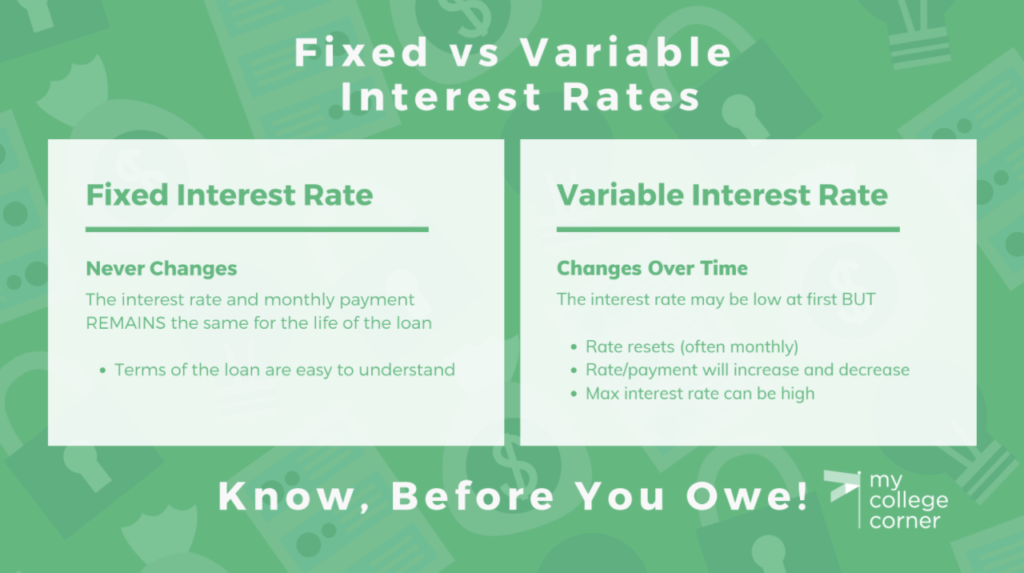
Picking a student loan that best meets your needs requires you to understand some basic concepts. Student Loan Basics is a series of articles to empower you with information about student loans and help you make smart financial choices.
This article:
- Defines what an interest rate is
- Explains the difference between fixed and variable interest rates
- Offers the pros and cons of each
- Identifies which student loan programs offer fixed and variable rate loans
- Provides questions for you to ask your lender
Interest rates, amortization schedules and simple vs. compound Interest
The interest rate on a loan is the cost of the loan to you. Let’s assume you borrow $1,000 and the lender charges an interest rate of 4%. In simple terms, this means that for each year you borrow the money, you pay $40 in interest. This would be 100% correct if your loan amount did not change over time.
Student loans amortize (pay off) over their life (a.k.a., the term) based on your monthly payment. Each monthly payment consists of an interest payment component and a principal payment so as each payment is made, a little more is used to pay down principal on the loan and a little less is allocated to interest (a.k.a. an amortization schedule.)
Student loans have the benefit of accruing interest using a technique called simple interest. Simple interest means that you pay interest only on the amount of your loan. Other types of loans charge interest on a compound basis. Compound interest requires a borrower to pay interest on the interest that is accruing each month. Student loan borrowers pay less in total interest cost because the loans are calculated using the simple interest method.
Fixed and Variable Interest Rates
A fixed-rate of interest is very straightforward. When you sign-up for a fixed-rate loan, the interest rate never changes. It remains the same over the life of the loan. In the example above, the 4% interest rate is a fixed rate.
A variable-rate of interest changes over time. The interest rate you are charged is only good for a certain period before it resets, i.e., changes. If the reset period is one month, then the interest rate will change at the beginning of the next month. For quarterly reset loans, the interest rate will change at the beginning of a calendar quarter (January 1, April 1, July 1, October 1). Annual resets usually occur on January 1.

For variable-rate loans there are three other important concepts:
- The index (a.k.a. base rate): interest rates on variable-rate loans are calculated from a base index. Most often, the index is a 1-month LIBOR.
- The margin (a.k.a. spread): the amount above the Base Rate that the lender will charge you for the loan. For example, a lender may charge you LIBOR plus 2.50% as your total interest rate. If one-month LIBOR is 1% and the lender is charging a spread of 2.50%, your interest rate is 3.50%.
- The cap rate (a.k.a. maximum or max interest rate): By law, variable rate loans must be capped so a borrower can be assured that the interest rate they pay will never exceed a certain percentage rate. Lenders will set a maximum allowable rate, which is very often the highest rate they are permitted to charge by law (a.k.a. usury rate).
For student loans, the most common reset period is one-month and the most common index is LIBOR.
There is not a common margin or cap rate. Lenders determine the margin on your loan based on your credit profile. Borrowers with the strongest credit will have a lower margin and will pay less in total interest cost. Lenders believe these borrowers are less likely to default or miss payments on loans. Conversely, borrowers with weak credit will be charged more because they are perceived to be at higher risk of making late payments or missing them entirely.
Pros and Cons of Fixed Rate Loans
Pros:
- The interest rate is set for the life of the loan.
- The monthly payment amount calculated at the time the loan is made will not change until the loan is repaid in full.
- The loan terms are easy to understand.
- If interest rates rise, there is no impact on your monthly payment amount or your total cost of credit.
Con:
- If interest rates go down, neither your monthly payment nor the total cost of credit will decrease.
Pros and Cons Variable Rate Loans
Pros:
- The initial variable rate, particularly for borrowers with very strong credit, will be less than a fixed-rate loan, sometimes substantially.
- If interest rates decline over the life of the loan, your monthly payment and the total cost of the loan will also decrease.
Cons:
- When you take out the loan, you don’t know, for sure, how much your monthly payment will be each month over the term of your loan.
- You also can’t know, with certainty, how much total interest you will pay for the loan over its entire life.
- If interest rates rise, your monthly payment and total cost of the loan will increase, potentially by a lot.
Interest Rates on Current Student Loan Programs
The U.S. Department of Education offers several different federal student loans for students and parents. All of the loans are offered on a fixed-rate basis, so the rate in effect when you borrow will not change over the life of the loan.
Banks, credit unions, financial services companies and several state-based agencies offer students and parents loans (a.k.a. Private Loans or Private Credit Loans). These lenders offer loans to borrowers who pass the lender’s credit test. Interest rates can be fixed or variable.
To find out more about the interest rates offered by your private credit lender, ask these questions:
- Is the interest rate fixed or variable?
- If a variable-rate loan, what is the base rate?
- With the variable-rate loan, how often does the interest rate reset?
- For a variable-rate loan, what is the maximum rate of interest I can pay?
- Based on the maximum rate of interest, what would be my monthly payment?
Looking for more? Check out this video to learn how interest rates impact loan repayment.
It’s vital to understand the basics of student loans before you select one. As we like to say: know before you owe.